专业英语-太阳能电池
- 格式:ppt
- 大小:1.26 MB
- 文档页数:18
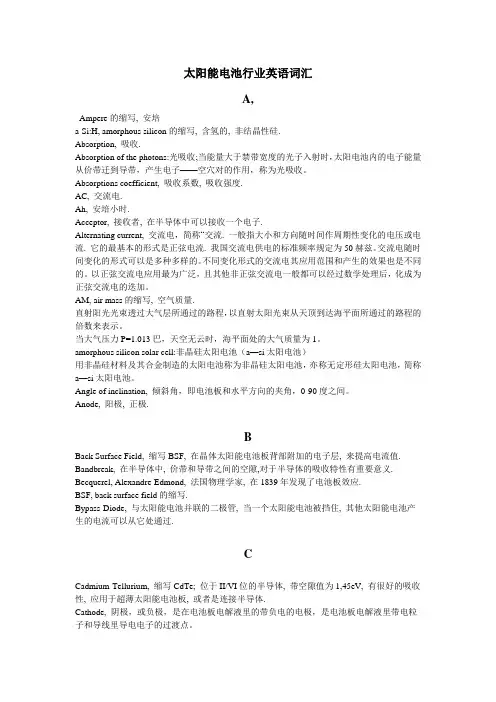
太阳能电池行业英语词汇A,Ampere的缩写, 安培a-Si:H, amorphous silicon的缩写, 含氢的, 非结晶性硅.Absorption, 吸收.Absorption of the photons:光吸收;当能量大于禁带宽度的光子入射时,太阳电池内的电子能量从价带迁到导带,产生电子——空穴对的作用,称为光吸收。
Absorptions coefficient, 吸收系数, 吸收强度.AC, 交流电.Ah, 安培小时.Acceptor, 接收者, 在半导体中可以接收一个电子.Alternating current, 交流电,简称“交流. 一般指大小和方向随时间作周期性变化的电压或电流. 它的最基本的形式是正弦电流. 我国交流电供电的标准频率规定为50赫兹。
交流电随时间变化的形式可以是多种多样的。
不同变化形式的交流电其应用范围和产生的效果也是不同的。
以正弦交流电应用最为广泛,且其他非正弦交流电一般都可以经过数学处理后,化成为正弦交流电的迭加。
AM, air mass的缩写, 空气质量.直射阳光光束透过大气层所通过的路程,以直射太阳光束从天顶到达海平面所通过的路程的倍数来表示。
当大气压力P=1.013巴,天空无云时,海平面处的大气质量为1。
amorphous silicon solar cell:非晶硅太阳电池(a—si太阳电池)用非晶硅材料及其合金制造的太阳电池称为非晶硅太阳电池,亦称无定形硅太阳电池,简称a—si太阳电池。
Angle of inclination, 倾斜角,即电池板和水平方向的夹角,0-90度之间。
Anode, 阳极, 正极.BBack Surface Field, 缩写BSF, 在晶体太阳能电池板背部附加的电子层, 来提高电流值. Bandbreak, 在半导体中, 价带和导带之间的空隙,对于半导体的吸收特性有重要意义. Becquerel, Alexandre-Edmond, 法国物理学家, 在1839年发现了电池板效应.BSF, back surface field的缩写.Bypass-Diode, 与太阳能电池并联的二极管, 当一个太阳能电池被挡住, 其他太阳能电池产生的电流可以从它处通过.CCadmium-Tellurium, 缩写CdTe; 位于II/VI位的半导体, 带空隙值为1,45eV, 有很好的吸收性, 应用于超薄太阳能电池板, 或者是连接半导体.Cathode, 阴极,或负极,是在电池板电解液里的带负电的电极,是电池板电解液里带电粒子和导线里导电电子的过渡点。


太阳能专业词汇名词解释字母AAA, Ampere的缩写, 安培a-Si:H, amorph silicon的缩写, 含氢的, 非结晶性硅.Absorption, 吸收.Absorption of the photons:光吸收;当能量大于到禁带宽度的光子入射时,太阳电池内的电子能量从价带迁导带,产生电子——空穴对的作用,称为光吸收。
Absorptions coefficien t, 吸收系数, 吸收强度.AC, 交流电.Ah, 安培小时.Acceptor, 接收者, 在半导体中可以接收一个电子.Alternating current, 交流电,简称“交流. 一般指大小和方向随时间作周期性变化的电压或电流. 它的最基本的形式是正弦电流. 我国交流电供电的标准频率规定为50赫兹。
交流电随时间变化的形式可以是多种多样的。
不同变化形式的交流电其应用范围和产生的效果也是不同的。
以正弦交流电应用最为广泛,且其他非正弦交流电一般都可以经过数学处理后,化成为正弦交流电的迭加。
AM, air mass的缩写, 空气质量.直射阳光光束透过大气层所通过的路程,以直射太阳光束从天顶到达海平面所通过的路程的倍数来表示。
当大气压力P=1.013巴,天空无云时,海平面处的大气质量为1。
amorphous silicon solar cell:非晶硅太阳电池(a—si太阳电池)用非晶硅材料及其合金制造的太阳电池称为非晶硅太阳电池,亦称无定形硅太阳电池,简称a—si太阳电池。
Angle of inclination, 倾斜角,即电池板和水平方向的夹角,0-90度之间。
Anode, 阳极, 正极.太阳能专业词汇名词解释字母BBack Surface Field, 缩写BSF, 在晶体太阳能电池板背部附加的电子层, 来提高电流值.Bandbreak, 在半导体中, 价带和导带之间的空隙,对于半导体的吸收特性有重要意义.Becquerel, Alexandre-Edmond, 法国物理学家, 在1839年发现了电池板效应.BSF, back surface field的缩写.Bypass-Diode, 与太阳能电池并联的二极管, 当一个太阳能电池被挡住, 其他太阳能电池产生的电流可以从它处通过.太阳能专业词汇名词解释字母CCadmium-Tellurid, 缩写CdTe; 位于II/VI位的半导体, 带空隙值为1,45eV, 有很好的吸收性, 应用于超薄太阳能电池板, 或者是连接半导体.Cathode, 阴极,或负极,是在电池板电解液里的带负电的电极,是电池板电解液里带电粒子和导线里导电电子的过渡点。
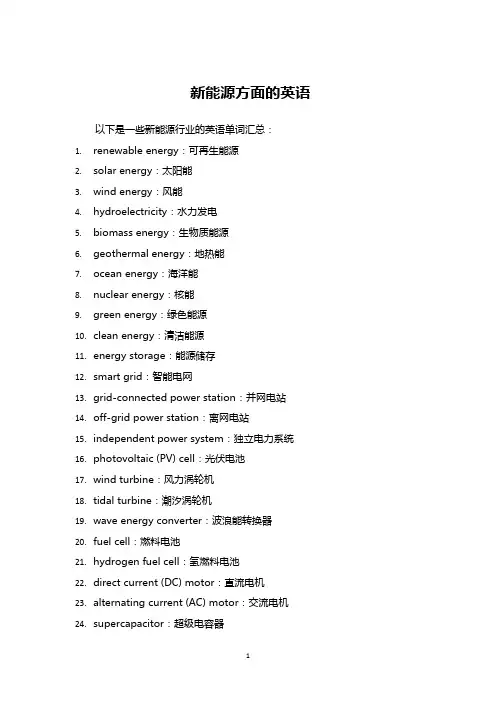
新能源方面的英语以下是一些新能源行业的英语单词汇总:1.renewable energy:可再生能源2.solar energy:太阳能3.wind energy:风能4.hydroelectricity:水力发电5.biomass energy:生物质能源6.geothermal energy:地热能7.ocean energy:海洋能8.nuclear energy:核能9.green energy:绿色能源10.clean energy:清洁能源11.energy storage:能源储存12.smart grid:智能电网13.grid-connected power station:并网电站14.off-grid power station:离网电站15.independent power system:独立电力系统16.photovoltaic (PV) cell:光伏电池17.wind turbine:风力涡轮机18.tidal turbine:潮汐涡轮机19.wave energy converter:波浪能转换器20.fuel cell:燃料电池21.hydrogen fuel cell:氢燃料电池22.direct current (DC) motor:直流电机23.alternating current (AC) motor:交流电机24.supercapacitor:超级电容器25.lithium-ion battery:锂离子电池26.lead-acid battery:铅酸电池27.nanomaterials:纳米材料28.smart meter:智能电表29.efficiency:效率30.conversion efficiency:转换效率。
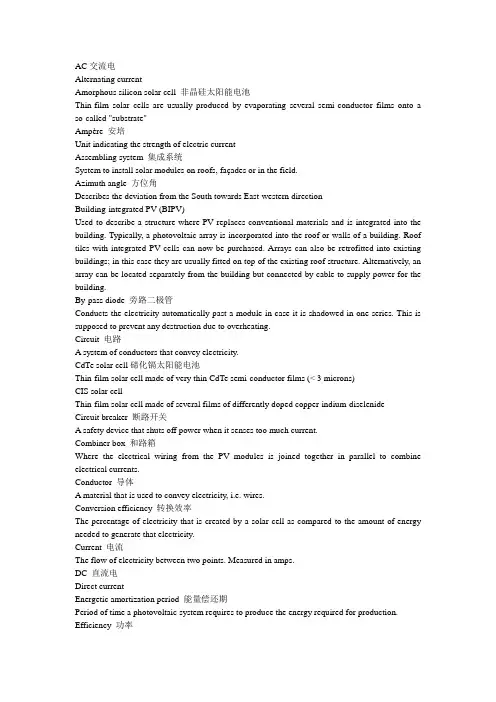
AC交流电Alternating currentAmorphous silicon solar cell 非晶硅太阳能电池Thin-film solar cells are usually produced by evaporating several semi-conductor films onto a so-called "substrate"Ampère 安培Unit indicating the strength of electric currentAssembling system 集成系统System to install solar modules on roofs, façades or in the field.Azimuth angle 方位角Describes the deviation from the South towards East-western directionBuilding-integrated PV (BIPV)Used to describe a structure where PV replaces conventional materials and is integrated into the building. Typically, a photovoltaic array is incorporated into the roof or walls of a building. Roof tiles with integrated PV cells can now be purchased. Arrays can also be retrofitted into existing buildings; in this case they are usually fitted on top of the existing roof structure. Alternatively, an array can be located separately from the building but connected by cable to supply power for the building.By-pass diode 旁路二极管Conducts the electricity automatically past a module in case it is shadowed in one series. This is supposed to prevent any destruction due to overheating.Circuit 电路A system of conductors that convey electricity.CdTe solar cell碲化镉太阳能电池Thin-film solar cell made of very thin CdTe semi-conductor films (< 3 microns)CIS solar cellThin-film solar cell made of several films of differently doped copper-indium-diselenideCircuit breaker 断路开关A safety device that shuts off power when it senses too much current.Combiner box 和路箱Where the electrical wiring from the PV modules is joined together in parallel to combine electrical currents.Conductor 导体A material that is used to convey electricity, i.e. wires.Conversion efficiency 转换效率The percentage of electricity that is created by a solar cell as compared to the amount of energy needed to generate that electricity.Current 电流The flow of electricity between two points. Measured in amps.DC 直流电Direct currentEnergetic amortization period 能量偿还期Period of time a photovoltaic system requires to produce the energy required for production. Efficiency 功率The ratio of output energy to input energy.Electrical grid 电网A large distribution network that delivers electricity over a wide area.Electrode 电极A conductor used to lead current into or out of a nonmetallic part of a circuit.Energy 能量Usable power. Measured in kWh.Energy audit 能量审核A process that determines how much energy you use in your house or apartment.Energy yield 能量输出Electric energy indicated in kWh yielded by a photovoltaic systemENSEquipment to control the grid with attributed all-pole control element in series. The ENS includes a redundant voltage and frequency control of the electricity grid and evaluates any leaps ascertained in the grid impedance. If the set limits are exceeded, the ENS will switch off the inverter. When the line voltage is re-established, the inverter will restart operation automatically. European efficiency rateWeighted efficiency rate is calculated by weighting different partial load efficiency rates and the full-load efficiency rate in line with the frequency of their appearance.Facade system 正面系统Photovoltaic system installed on the facade of a building or an integral part of a facade.Feed-in meter 输入计Measuring instrument for the supply of electric energy into the public power grid (unit in kWh) Mismatching interconnection of better and worse modules in one string as a consequence of which the worst module of one series determines the electricity.Field system 野外系统Photovoltaic system installed in a fieldFlat-roof system 平台屋顶系统Photovoltaic system installed on a flat roof.Fossil fuels 矿物燃料Fuels that are formed underground from the remains of dead plants and animals. i.e. oil, natural gas, and coal are fossil fuels.Global radiation 总辐射Sum of diffuse, direct and reflected solar radiation onto a horizontal surface.Greenhouse effect 温室效应When heat from the sun becomes trapped in the Earth's atmosphere due to certain gases. Greenhouse gases 温室气体The gases responsible for trapping heat from the sun within the Earth's atmosphere. i.e. water vapor, carbon dioxide, methane, ozone, chlorofluorocarbons, and nitrogen oxides.Grid 电网A distribution network, including towers, poles, and wires that a utility uses to deliver electricity. Grid-connected PV system 并网光伏系统When the electricity grid is available but electricity from a clean source (solar) is desired, solar panels can be connected to the grid. Provided that sufficient panels are placed, the appliances inthe house/building will then run on solar electricity. A grid-connected solar electricity system basically consists of one or more solar panels, an inverter, cables, the electric load and a support structure to mount the solar panels.Hertz (HZ) 赫兹The frequency of electrical current described in cycles per second, i.e. Appliances in the United States use 60 HZ.Inverter 逆变器Converts the DC output of the PV system into usable AC output that can be fed directly into the building load.Irradiance 辐照度the amount of solar energy that strikes a surface during a specific time period. Measured in kilowatts.I-V curve IV曲线A graph that plots the current versus the voltage from the solar cell as the electrical load (or resistance) is increased from short circuit (no load) to open circuit (maximum voltage). The shape of the curve characterizing cell performance. Three important points on the IV curve are the open-circuit voltage, short-circuit current, and peak or maximum power (operating) point. Junction box The point on a solar module where it connects, or is strung, to other solar modules. In-roof installation 镶嵌屋顶系统Photovoltaic system which is integrated into the roof claddingIsland system 独立系统Grid-independent power supply systemkWh – kilowatt hourUnit indicating energy/work and corresponding with the performance of one kilowatt during a period of one hourkWp - Kilowatt peakUnit indicating the maximum performance under standard test concitions (STC)Load 负载The amount of electrical demand used in the building at any given time.Mono-crystalline silicon solar cell 单晶硅太阳能系统Basic raw material is a monocrystal drawn from melted silicon.Multi-crystalline silicon solar cell 多晶硅太阳能电池Basic raw material is solar silicon cast in blocks.National Electrical Code (NEC) 国家电气代码The U.S. minimum inspection requirements for all types of electrical installations, including solar systems.National Electrical Manufacturers Association (NEMA) 国家电力生产商协会The U.S. trade association that develops standards for the electrical manufacturing industry. NREL The National Renewable Energy Laboratory 国家可再生能源实验室A national lab that concentrates on studying and developing renewable energy sources.Open circuit voltage 开路电压Maximum voltage in an electric circuit which is generated when the electricity I equals zero (depending on termperature).Performance guarantee 性能质保Extended guarantee of the module producer for the performance of the solar modules. Performance tolerance 性能公差Tolerance stated by the producer with regards to the nominal power.Poly-cristalline solar cell 多晶硅太阳能电池See multi-crystalline silicon solar cell.PSC 电力供应公司Power supply companies.Peak load 最大负荷The largest amount of electricity being used at any one point during the day.Photovoltaic (PV) 光伏the conversion of light into electricity. The term "photo" comes from the Greek "phos," meaning light. "V oltaic" is named for Alessandro V olta (1745-1827), a pioneer in the study of electricity for whom the term "volt" was named. Photovoltaics, then, means "light electricity."Photovoltaic (PV) module 光伏组件A number of photovoltaic cells electrically interconnected and mounted together, usually in a sealed unit of convenient size for shipping, handling and assembling into arrays. The term "module" is often used interchangeably with the term "panel.Photovoltaic array 光伏阵列An interconnected system of solar modules that function as a single electricity-producing unit. Photovoltaic cell 光伏电池(格)This is the basic unit of a solar module that collects the sun's energy.Photovoltaic system 光伏系统A complete set of components that converts sunlight into usable electricity.Rectifier 整流器Transforms alternating current into direct currentRoof inclination 屋顶倾斜度Angle of a roof towards the horizontalRated power 额定功率Nominal power output of an inverter; some units cannot produce rated power continuously. Semiconductor A material that has an electrical conductivity in between that of a metal and an insulator. Typical semiconductors for PV cells include silicon, gallium arsenide, copper indium diselenide, and cadmium elluride.Short-circuit electricity 短路电流Maximum electricity in an electric circuit, which is generated when the voltage U at the terminals equals zero (proportional to solar radiation).Solar generatorSum of solar modules.Specific energy yield 能量生产率(比能率)Electric energy indicated in kWh and yielded by a photovoltaic system divided by the installed performance (kWp).Standard Test Conditions – STC 标准测试条件General conditions under which the perfomance of a solar module is measured in a laboratory. Constant factors for measuring are: Irradiance of 1,000W/m²5f; light spectrum after penetration of 1.5fold density of the atmosphere (AM1,5); temperature of the solar cell 25°C.Supply meter 电源表Measuring instrument for the supply of electric energy from the public power grid (unit in kWh) Termperature coefficient 温度系数Indicates to what extent the individual factor changes with the temperature. Temperature-independent factors are voltage, electricity and consequently also performance.Thin-film solar cell 薄膜太能能电池Roughly a hundred times thinner than crystalline cells. Industrial production procedure (evaporation, atomization procedure…) onto the substrate lowers the cost. Doping specific contamination of purest silicon with impurity atoms. In a so-called diffusion procedure, impure atoms (e.g. borum, phosphor), which can give off electrons, are transported below the surface of the wafers.Three-phase voltage control 三相电压控制器Equipment to control the grid. V oltage control of the three phases. If a voltage falls below a stipulated limit, the equipment will be switched off.Tilt angle 倾斜角The angle of inclination of a module measured from the horizontal.Transformer 变压器Used to step up or down the voltage emerging from the inverter to match the required voltage of the onsite load or the utility interconnection.V olt 伏特Unit indicating the voltage.Watt 瓦特Unit indicating the performance.WhUnit indicating the watthour.WpUnit indicating the wattpeak.。
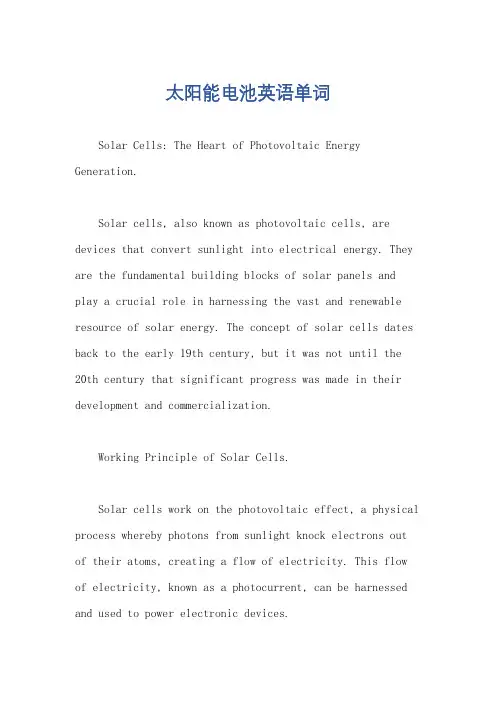
太阳能电池英语单词Solar Cells: The Heart of Photovoltaic Energy Generation.Solar cells, also known as photovoltaic cells, are devices that convert sunlight into electrical energy. They are the fundamental building blocks of solar panels and play a crucial role in harnessing the vast and renewable resource of solar energy. The concept of solar cells dates back to the early 19th century, but it was not until the20th century that significant progress was made in their development and commercialization.Working Principle of Solar Cells.Solar cells work on the photovoltaic effect, a physical process whereby photons from sunlight knock electrons out of their atoms, creating a flow of electricity. This flow of electricity, known as a photocurrent, can be harnessed and used to power electronic devices.The core of a solar cell is typically made up of silicon, a semiconductor material. When sunlight hits the silicon surface, it excites the electrons in the atoms, causing them to jump out of their original orbit and leave behind positively charged atoms, known as holes. These electrons and holes then migrate to different sides of the cell, creating a separation of charges and resulting in a voltage difference, or a potential difference, across the cell.Types of Solar Cells.Solar cells can be classified into several types based on their structure and materials used. Some of the common types include:1. Crystalline Silicon Solar Cells: These are the most common type of solar cells and are made from silicon wafers. They are further classified into monocrystalline and polycrystalline varieties. Monocrystalline solar cells are made from a single crystal of silicon and have higherefficiency but are more expensive to produce. Polycrystalline solar cells are made from multiple silicon crystals and are less efficient but cheaper to produce.2. Thin-Film Solar Cells: These solar cells are made from very thin layers of semiconducting materials, such as silicon, copper indium gallium selenide (CIGS), cadmium telluride (CdTe), and amorphous silicon. They are less efficient than crystalline silicon solar cells but are cheaper to produce and can be applied to flexible substrates, making them suitable for use in curved surfaces and lightweight applications.3. Multi-junction Solar Cells: These solar cells are composed of multiple layers of semiconducting materials, each optimized to absorb a different part of the solar spectrum. They are typically used in spacecraft and high-efficiency solar power systems where weight and space are limited.4. Dye-Sensitized Solar Cells (DSSC): These solar cells use a photosensitive dye to absorb sunlight and convert itinto electricity. They are relatively new and still in the research and development stage but offer the potential for low-cost and efficient solar energy conversion.Applications of Solar Cells.Solar cells have a wide range of applications, from powering small electronic devices to large-scale solar power plants. Some of the common applications include:1. Residential Solar Power Systems: Solar cells can be installed on rooftops or in open spaces to generate electricity for household use. This reduces dependency on grid electricity and can help homeowners save money on their utility bills.2. Utility-Scale Solar Power Plants: Large-scale solar power plants use thousands of solar cells mounted on trackers or fixed mounts to generate electricity for commercial use. These plants can supply power to utilities and distribute it to customers through the electric grid.3. Mobile and Portable Devices: Solar cells are often used to power mobile phones, laptops, and other portable electronic devices. They can be integrated into the devices themselves or attached as external power packs.4. Spacecraft and Satellites: Solar cells are essential for powering spacecraft and satellites. They provide a reliable and efficient source of electricity in space, where there is no access to fossil fuels or othertraditional power sources.Advantages and Challenges of Solar Cells.Solar cells offer several advantages as a renewable energy source:Renewable and Sustainable: Solar energy is an infinite resource, and solar cells convert it into electricity without emitting greenhouse gases or other pollutants.Low Maintenance: Solar cells have no moving parts and require minimal maintenance once installed.Scalable: Solar cells can be scaled up or down to meet different power requirements, from small devices to large-scale power plants.However, there are also some challenges and limitations to solar cell technology:Cost: Although solar cell technology has become more affordable in recent years, the initial investment cost can still be high compared to traditional power sources.Efficiency: The efficiency of solar cells, measured as the percentage of sunlight converted into electricity, is still relatively low compared to fossil fuel-based power plants.Weather Dependence: Solar cells rely on sunlight to generate electricity, so their performance can be affected by cloudy or rainy weather.Conclusion.Solar cells are a crucial component of solar energy systems and play a vital role in harnessing the vast potential of solar energy. With continued research and development, solar cell technology is expected to become more efficient, affordable, and widely used, contributing to a cleaner, more sustainable energy future.。
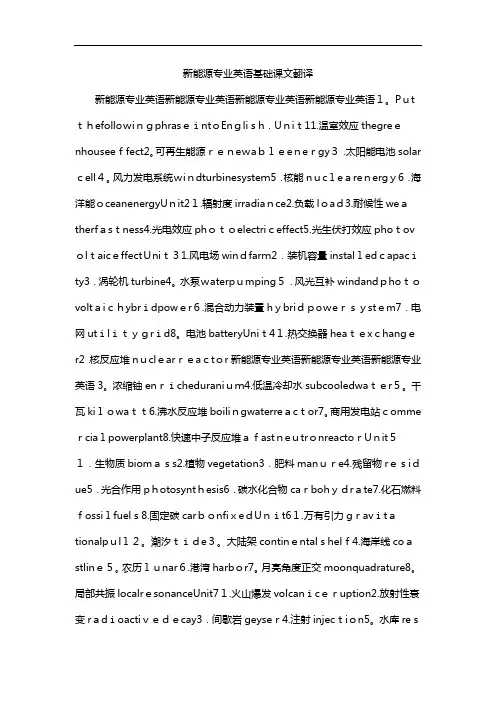
新能源专业英语基础课文翻译新能源专业英语新能源专业英语新能源专业英语新能源专业英语1。
Put thefollowingphraseintoEnglish.Unit11.温室效应thegreenhouseeffect2。
可再生能源renewableenergy3.太阳能电池solar cell4。
风力发电系统windturbinesystem5.核能nuclearenergy6.海洋能oceanenergyUnit21.辐射度irradiance2.负载load3.耐候性weatherfastness4.光电效应photoelectriceffect5.光生伏打效应photov oltaiceffectUnit31.风电场windfarm2.装机容量installedcapacity3.涡轮机turbine4。
水泵waterpumping5.风光互补windandphotovoltaichybridpower6.混合动力装置hybridpowersystem7.电网utilitygrid8。
电池batteryUnit41.热交换器heatexchanger2.核反应堆nuclearreactor新能源专业英语新能源专业英语新能源专业英语3。
浓缩铀enricheduranium4.低温冷却水subcooledwater5。
千瓦kilowatt6.沸水反应堆boilingwaterreactor7。
商用发电站comme rcialpowerplant8.快速中子反应堆afastneutronreactorUnit51.生物质biomass2.植物vegetation3.肥料manure4.残留物residue5.光合作用photosynthesis6.碳水化合物carbohydrate7.化石燃料fossilfuels8.固定碳carbonfixedUnit61.万有引力gravitationalpull2。
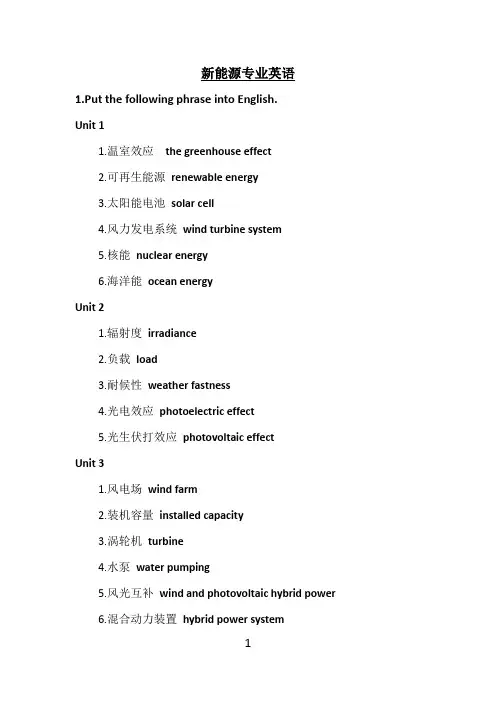
新能源专业英语1.Put the following phrase into English.Unit 11.温室效应the greenhouse effect2.可再生能源renewable energy3.太阳能电池solar cell4.风力发电系统wind turbine system5.核能nuclear energy6.海洋能ocean energyUnit 21.辐射度irradiance2.负载load3.耐候性weather fastness4.光电效应photoelectric effect5.光生伏打效应photovoltaic effectUnit 31.风电场wind farm2.装机容量installed capacity3.涡轮机turbine4.水泵water pumping5.风光互补wind and photovoltaic hybrid power6.混合动力装置hybrid power system7.电网utility grid8.电池batteryUnit 41.热交换器heat exchanger2.核反应堆nuclear reactor3.浓缩铀enriched uranium4.低温冷却水subcooled water5.千瓦kilowatt6.沸水反应堆boiling water reactor7.商用发电站commercial power plant8.快速中子反应堆a fast neutron reactor Unit 51.生物质biomass2.植物vegetation3.肥料manure4.残留物residue5.光合作用photosynthesis6.碳水化合物carbohydrate7.化石燃料fossil fuels8.固定碳carbon fixedUnit 61.万有引力gravitational pull2.潮汐tide3.大陆架continental shelf4.海岸线coastline5.农历lunar6.港湾harbor7.月亮角度正交moon quadrature8.局部共振local resonanceUnit 71.火山爆发volcanic eruption2.放射性衰变radioactive decay3.间歇岩geyser4.注射injection5.水库reservoir6.裂纹crackUnit 81.利用harness2.盐度salinity3.潮汐tide4.动能kinetic energy5.水力发电hydro-electric power6.引力gravitational pull2.Translate the following sentences.Unit 11.Energy is an important material and energy foundation of human survival and development , its plays a vital role in the development of human civilization . New energy usually refers to the new energy technologies based on new development and utilization of energy , including solar , biomass , wind , geothermal , ocean energy and hydrogen etc.能源是人类生存和发展的重要材料和能量基础,它在人类文明的发展中扮演着至关重要的角色。
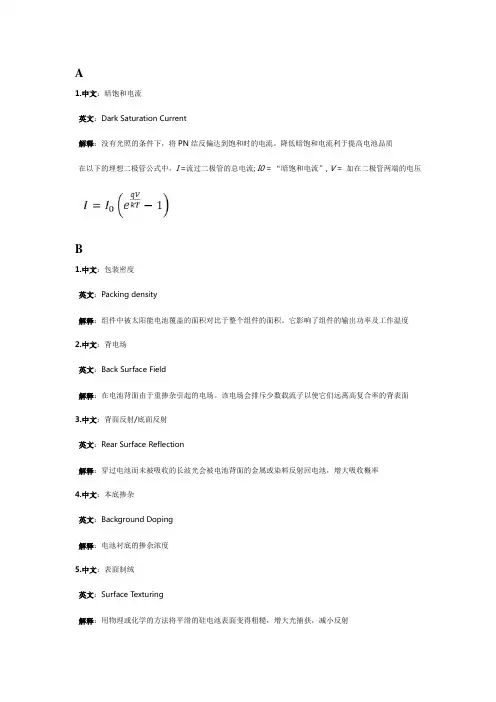
A1.中文:暗饱和电流英文:Dark Saturation Current解释:没有光照的条件下,将PN结反偏达到饱和时的电流。
降低暗饱和电流利于提高电池品质在以下的理想二极管公式中,I =流过二极管的总电流; I0 = “暗饱和电流”, V = 加在二极管两端的电压B1.中文:包装密度英文:Packing density解释:组件中被太阳能电池覆盖的面积对比于整个组件的面积。
它影响了组件的输出功率及工作温度2.中文:背电场英文:Back Surface Field解释:在电池背面由于重掺杂引起的电场。
该电场会排斥少数载流子以使它们远离高复合率的背表面3.中文:背面反射/底面反射英文:Rear Surface Reflection解释:穿过电池而未被吸收的长波光会被电池背面的金属或染料反射回电池,增大吸收概率4.中文:本底掺杂英文:Background Doping解释:电池衬底的掺杂浓度5.中文:表面制绒英文:Surface Texturing解释:用物理或化学的方法将平滑的硅电池表面变得粗糙,增大光捕获,减小反射6.中文:并网系统英文:Grid-connected Systems解释:并网系统指由光伏组件供电的,接入公用电网的光伏系统。
这类系统无须蓄电池7.中文:薄膜太阳能电池英文:Thin-film Solar Cells解释:薄膜太阳能电池是通过在衬底上镀光伏材料薄层制成的,厚度从几微米到几十微米不等。
成本较低但效率普遍较低8.中文:复合英文:Recommbination解释:又称为载流子复合,是指半导体中的载流子(电子和空穴)成对消失的过程。
9.中文:表面复合速率英文:Surface Recombination Velocity解释:当少子在表面消失时,由于浓度梯度,少子会从电池体流向表面。
表面复合速度表征表面复合的强弱。
C1.中文:掺杂英文:Doping解释:在本征半导体里加入施主或受主杂质(通常是磷或硼)使半导体内自由载流子浓度变高并使其具有p型或n型半导体的性质2.中文:串联电阻英文:Series Resistance解释:由电池体、电极接触等产生的分压电阻。
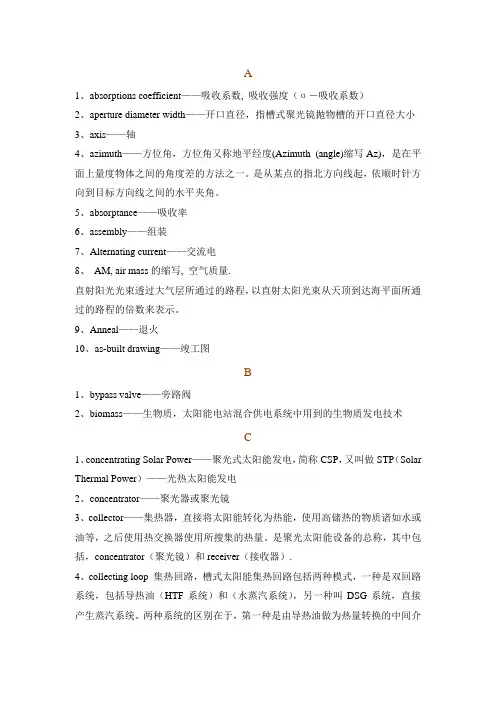
A1、absorptions coefficient——吸收系数, 吸收强度(α-吸收系数)2、aperture diameter width——开口直径,指槽式聚光镜抛物槽的开口直径大小3、axis——轴4、azimuth——方位角,方位角又称地平经度(Azimuth (angle)缩写Az),是在平面上量度物体之间的角度差的方法之一。
是从某点的指北方向线起,依顺时针方向到目标方向线之间的水平夹角。
5、absorptance——吸收率6、assembly——组装7、Alternating current——交流电8、AM, air mass的缩写, 空气质量.直射阳光光束透过大气层所通过的路程,以直射太阳光束从天顶到达海平面所通过的路程的倍数来表示。
9、Anneal——退火10、as-built drawing——竣工图B1、bypass valve——旁路阀2、biomass——生物质,太阳能电站混合供电系统中用到的生物质发电技术C1、concentrating Solar Power——聚光式太阳能发电,简称CSP,又叫做STP(Solar Thermal Power)——光热太阳能发电2、concentrator——聚光器或聚光镜3、collector——集热器,直接将太阳能转化为热能,使用高储热的物质诸如水或油等,之后使用热交换器使用所搜集的热量。
是聚光太阳能设备的总称,其中包括,concentrator(聚光镜)和receiver(接收器).4、collecting loop 集热回路,槽式太阳能集热回路包括两种模式,一种是双回路系统,包括导热油(HTF系统)和(水蒸汽系统),另一种叫DSG系统,直接产生蒸汽系统。
两种系统的区别在于,第一种是由导热油做为热量转换的中间介质,而后者是太阳能直接转化为水蒸气的热能。
第一种系统效率低于第二种,第二种技术对集热管要求较高。
(Skyfuel公司在文件中介绍的便是采用南北向布置的双回路带储能的槽式发电系统。
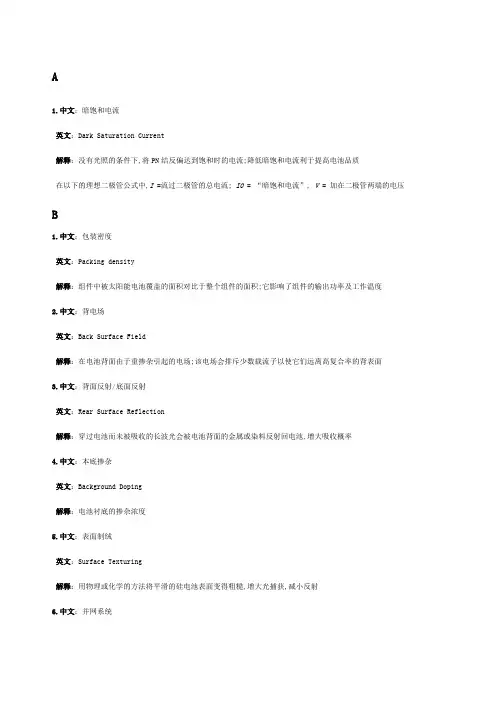
A1.中文:暗饱和电流英文:Dark Saturation Current解释:没有光照的条件下,将PN结反偏达到饱和时的电流;降低暗饱和电流利于提高电池品质在以下的理想二极管公式中,I =流过二极管的总电流; I0= “暗饱和电流”, V = 加在二极管两端的电压B1.中文:包装密度英文:Packing density解释:组件中被太阳能电池覆盖的面积对比于整个组件的面积;它影响了组件的输出功率及工作温度2.中文:背电场英文:Back Surface Field解释:在电池背面由于重掺杂引起的电场;该电场会排斥少数载流子以使它们远离高复合率的背表面3.中文:背面反射/底面反射英文:Rear Surface Reflection解释:穿过电池而未被吸收的长波光会被电池背面的金属或染料反射回电池,增大吸收概率4.中文:本底掺杂英文:Background Doping解释:电池衬底的掺杂浓度5.中文:表面制绒英文:Surface Texturing解释:用物理或化学的方法将平滑的硅电池表面变得粗糙,增大光捕获,减小反射6.中文:并网系统英文:Grid-connected Systems解释:并网系统指由光伏组件供电的,接入公用电网的光伏系统;这类系统无须蓄电池7.中文:薄膜太阳能电池英文:Thin-film Solar Cells解释:薄膜太阳能电池是通过在衬底上镀光伏材料薄层制成的,厚度从几微米到几十微米不等;成本较低但效率普遍较低8.中文:复合英文:Recommbination解释:又称为载流子复合,是指半导体中的载流子电子和空穴成对消失的过程;9.中文:表面复合速率英文:Surface Recombination Velocity解释:当少子在表面消失时,由于浓度梯度,少子会从电池体流向表面;表面复合速度表征表面复合的强弱;C1.中文:掺杂英文:Doping解释:在本征半导体里加入施主或受主杂质通常是磷或硼使半导体内自由载流子浓度变高并使其具有p型或n型半导体的性质2.中文:串联电阻英文:Series Resistance解释:由电池体、电极接触等产生的分压电阻;电池运作时,部分电压降在电池的串联电阻上,影响了电池输出效率D1.中文:大气质量/大气光学质量英文:Air Mass解释:定义为1/cos太阳与法线夹角;表征太阳光到达电池前穿越的大气厚度;不同的AM值还对应不同的太阳光谱2.中文:带隙英文:Band Gap解释:半导体导带与价带之间的能级差;常温下,本征硅的带隙是3.中文:导带英文:Conduction Band解释:又名传导带,是指半导体或是绝缘体材料中,一个电子所具有能量的范围;这个能量的范围高于价带valence band,而所有在导带中的电子均可经由外在的电场加速而形成电流;4.中文:电池工作温度英文:Cell Operating Temperature解释:太阳能电池在受到光照激发产生电流时的实际温度;工作温度通常高于标准测试条件STC规定的25摄氏度, 并且会影响电池的开路电压5.中文:电池互联英文:Cell Interconnection解释:将电池板串联一起组成电池组件6.中文:电池降格英文:Cell Degradation解释:电池降格指组件在户外工作一段时间后,效能降低;对晶硅电池来说原因包括:电极脱落或被腐蚀,电极金属迁移透过P-N节而降低了并联电阻,减反膜老化,P型材料中形成了硼氧化物等7.中文:电流电压特性英文:Current-Voltage Charateristic解释:又称为伏安特性,是电子器件的在外部电压偏置的情况下电流随外部变压变化的特性,常用伏安特性曲线来表征;8.中文:电子空穴对英文:Electron-hole Pair解释:半导体中,吸收了一个光子能量的电子离开原子束缚,成为自由载流电子,原来的原子则产生了正电荷,等效于一个孔穴,它们合称电子空穴对9.中文:独立系统英文:Stand-alone Systems解释:不接入公用电网的独立光伏发电系统,通常需要蓄电池蓄能以备夜间及阴天使用,也常装备柴油发电机作为补充10.中文:短路电流英文:Short Circuit Current Isc解释:在光照下将电池短路,此时流过电池的电流为短路电流;表征电池能产生的光电流强度;11.中文:多晶硅英文:Polycrystalline/Multicrystalline silicon解释:在硅晶体里面,晶向的分布式随机的而不是同一的,相较于单晶硅生产成本低但材料品质也较差12.中文:等离子增强化学气相沉积法英文:Plasma enhanced, Chemical Vapor Deposition PECVD解释:一种镀膜技术;常用于在晶硅电池表面镀氮化硅,二氧化硅,氧化铝等薄膜;E1.中文:额定功率英文:Rated Power/Rated Watt解释:太阳能电池板在国际通行标准条件下光谱,光强1000W/平米,温度25C测试出来的输出功率,实际的输出功率受使用环境影响F1.中文:反偏英文:Reverse Bias解释:对于p-n节来说,指n-type接高电势,p-type接低电势2.中文:方块电阻率/薄层电阻率英文:Sheet Resistivity解释:通常表征发射极掺杂浓度的高低;高掺杂则电阻率低但削弱蓝光响应;可通过四点探针测量3.中文:非晶硅/无定形硅英文:Amorphous Silicon解释:硅的一种同素异形体,它的原子间的晶格网络呈无序排列,不存在晶体硅的延展性晶格结构;无定形硅中的部分原子含有悬空键dangling bond,虽然可以被氢所填充,但在光的照射下,氢化无定形硅的导电性能将会显着衰退;4.中文:分布式光伏系统英文:Distributed PV Systems解释:小型模块化、分散式、布置在用户附近的,依靠光伏组件发电的电力系统;5.中文:分流电阻/并联电阻英文:Shunt Resistance解释:在太阳能电池等效电路中,并联于电池两端的漏电阻;该电阻会分流掉部分光电流,因此并联电阻越大越好6.中文:封装英文:Encapsulation解释:指将已互联的电池通过层压密封到电池组件里;封装可以实现电池组件防水,防潮,并且增强电池的机械性能;7.中文:峰瓦英文:Peak Watts解释:组件在理想的标准测试条件下的输出功率, 该功率值也是组件的额定功率;8.中文:峰值日照小时数英文:Peak Sun Hours解释:这是一个等效概念,表征一天中太阳的辐射总能量;数值上等于一天中太阳的总辐射能量千瓦时/平方米除以1 千瓦/平方米9.中文:伏安特性曲线英文:I-V Curve解释:用来表征电子器件的在外部电压偏置的情况下电流随外部变压变化的特性曲线;10.中文:复合英文:Recommbination解释:又称为载流子复合,是指半导体中的载流子电子和空穴成对消失的过程;11.中文:复合损失英文:Recombination Loss解释:在被电极收集之前电子与空穴的复合使电能流失;12.中文:副栅线英文:Fingers解释:太阳能电池的电极的一部分,用于收集积累于电池表面的电荷从而形成外电路电流;副栅线通常由丝网印刷金属浆料或者电镀金属形成,宽度小于130微米,与主栅bus bar相连;G1.中文:跟踪英文:Tracking解释:在电池组件上安装智能的制动系统使组件始终朝向太阳以获得最大辐射量2.中文:光捕获/光陷阱英文:Light Trapping解释:通过散射与折射使光进入电池后就被限制在电池内部传播直至大部分被完全吸收3.中文:光伏效应英文:Photovoltaic Effect解释:指在光照激发下的半导体或半导体与金属组合的部位间产生电势差的现象;由于材料内部的参杂不均匀,在内建电场的作用下,受到激励的电子和失去电子的空穴向相反方向移动,而形成了正负两级;此效应最早于1839年由法国物理学家亚历山大·埃德蒙·贝克勒尔发现;4.中文:光谱响应英文:Spectral Response解释:指电池对不同波长的单色光的响应; 通常以量子效率来呈现这种响应;5.中文:光学损失英文:Optical Loss解释:入射光由于受到电池的表面反射,电极遮挡等因素影响而无法在电池中激发载流子形成的损失;通过光陷阱的设计和对电极遮挡的优化可以有效减少光学损失;6.中文:光照强度英文:Light Intensity解释:单位面积接收到的光照功率,单位是瓦/平方米7.中文:光子英文:Photon解释:是传递电磁相互作用的基本粒子,也是电磁辐射的载体;光子具有波利二象性:既能表现经典波的折射、干涉和衍射等性质,作为粒子性的光子只能传递量子化的能量,即: E=hv,其中h是普朗克常数,v是光波的频率;8.中文:光伏建筑一体化英文:Building Integrated PV BIPV解释:是使用太阳能光伏材料取代传统建筑材的一种应用方式,通常利用天窗和外墙是作为最大的接光面,使建筑物本身能够为自身提供能源,可以部分或全部供应建筑用电,而不必用外加方式加装太阳能板;由于在建筑设计阶段提前规划,所以发电率和成本比值最佳;H1.中文:耗尽区/耗尽层英文:Depletion Region解释:指在P-N节中P型与N型的交界面周围的区域,通常有几个微米宽;由于该区域内建电场的存在,多数载流子被排斥而形成耗尽区;J1.中文:激光刻槽埋栅太阳能电池英文:Laser Grooved, Buried Contact Solar Cells解释:由新南威尔士大学研究中心开发的电极设计;激光刻槽使副栅线深埋入电池,在减少电极遮光的同时保持良好的导电;2.中文:寄生电阻英文:Parasitic Resistance解释:电池串联电阻与并联电阻的总称;3.中文:价带英文:Valence Band解释:通常是指半导体中在绝对零度下能被电子占满的最高能带;全充满的价带中的电子不能在固体中自由运动;4.中文:交错背接触电池英文:Interdigitated Back Contact IBC Cell解释:电池的正负极接触都在背面,并且相互交叉,其结构如图所示;5.中文:减反膜英文:Antireflection Coating解释:在电池表面镀上的薄膜,它使入射光由于干涉相消而减少反射率,理想情况下,单层减反膜可使一个特定波长的光的反射率降为零6.中文:金属化形成电极英文:Metallisation解释:在电池的正表面或背表面上加上金属使电池形成电极接触7.中文:金字塔表面制绒结构英文:Pyramids解释:碱溶液对单晶硅的腐蚀是各项异性的,在制绒过程中单晶硅的特定晶面会暴露出来,使得制绒后的硅表面出现数微米高的金字塔8.中文:禁带英文:Forbidden Gap解释:在能带结构中能态密度为零的能量区间;常用来表示价带和导带之间的能态密度为零的能量区间;9.中文:单晶硅/晶体硅英文:Crystalline Silicon/Monocrystalline Silicon解释:硅的单晶体,具有基本完整的点阵结构,纯度高;10.中文:接触电阻英文:Contact Resistance解释:指电流流过半导体与电极金属界面所克服的电阻; 该电阻是电池总串联电阻的一部分11.中文:间接带隙半导体英文:Indirect Band-gap semiconductor解释:指半导体的能带图上导带底与价带顶不在同一动量上;需要光子与声子共同作用来激发电子孔穴对;硅就是常见的间接带隙半导体12.中文:聚光光伏英文:Concentrator PV CPV解释:通过光学器件将太阳光聚集到电池表面, 等效于太阳能电池有了更大的受光面积K1.中文:开路电压英文:Open Circuit Voltage Voc解释:电池光照下并且电路处于开路状态时,正负电极之间产生的电势差;开路电压衡量了电池可以达到的最高电压;2.中文:扩散英文:Diffusion解释:是粒子通过随机运动从高浓度区域向低浓度区域的网状的传播;在光伏应用中,扩散用于向衬底中参杂施主或受主原子以形成p-n结或高低结3.中文:扩散长度/载流子扩散长度英文:Diffusion Length解释:半导体中载流子在复合前平均移动的距离;与少子寿命及扩散系数成正比,一般扩散长度越长材料的质量越高;L1.中文:理想二极管定律英文:Ideal Diode Law解释:电池在无光照情况下的电流电压关系满足如下理想二极管公式 I=I_0expqV/kT-12.中文:理想因子英文:Ideality Factor解释:用于描述电池等效电路模型中的二极管和理想二极管的接近程度;由于理想二极管方程有一些前提假设,而实际二极管会因一些二阶效应的影响表现出与理想二极管不同,理想因子被用于表征这种差异;3.中文:硫化蓄电池英文:Sulfation解释:由于长期处在低充电量状态下,蓄电池电极出现硫酸铅晶体的现象称为硫化;硫化会使电池容量及充放电效率降低;M1.中文:漫射辐射英文:Diffuse Radiation解释:通常指阴天条件下的太阳光辐射,其特点是辐射能量沿各个方向传播且光强低;2.中文:冥王星电池英文:Pluto solar cells解释:由尚德电力主导研发的一种高效率太阳能电池;它具备激光参杂,选择性发射级,以及背表面局部接触等特点;2012年初,其在6英寸直拉单晶硅片转换效率达到%;N1.中文:N 型半导体英文:N-type semiconductor解释:在半导体中由于掺入施主元素而使得电子成为半导体内的多数载流子;常用来制成N型半导体的施主元素为磷2.中文:逆变器英文:Inverter解释:又称变流器、反流器,或称反用换流器、电压转换器,是一个利用高频电桥电路将直流电变换成交流电的电子器件,其目的与整流器相反;P1.中文:P-N 结英文:p-n junction解释:P型与N型半导体相接处形成的特殊界面;由于内建电场存在,电流容易从P型流向N型,反之则困难;太阳能电池利用P-N节将被光激发的少数载流子从P-N节的一端迁移到另一端2.中文:P 型半导体英文:p-type semiconductor解释:在半导体中由于掺入受主元素而使得空穴成为半导体内的多数载流子;常用来制成P型半导体的施主元素为硼3.中文:旁路二极管英文:Bypass diode解释:是电池组件中用于防止组件由于遮挡产生局部过热而附加的安全器件;旁路二极管与其所保护的电池并联,但是二极管极性与电池相反;R1.中文:日照常数英文:Solar Constant解释:数值上等于峰值日照小时数,没有单位;S1.中文:砷化镓英文:Gallium Arsenide解释:由ⅢA族元素Ga和ⅤA族元素As化合而成的半导体材料;分子式为GaAs;室温下禁带宽度为,属直接跃迁型能带结构;2.中文:失谐损失英文:Mismatch Losses解释:如果组件中串联的电池板输出电流的不一致,则总电流受最小电流限制,因而造成功率损失;3.中文:死层英文:Dead Layer解释:参杂浓度过高的电池前表面参杂区域;这会导致表层载流子寿命显着减少,电池对短波长光谱反映严重衰减; T1.中文:体电阻英文:Bulk Resistance解释:电流流穿电池衬底时所需克服的电阻;由电池的本底掺杂浓度决定2.中文:填充因子英文:Fill Factor解释:定义了电池最大输出功率和开路电压与短路电流乘积的比值;在图形上,填充因子描述了电池伏安特性曲线的“直方性”;填充因子越大,伏安曲线约接近于方形;3.中文:铜铟镓硒薄膜电池英文:CuInxGa1-xSe2 CIGS解释:具有稳定性好、抗辐照性能好、成本低、效率高等优点;但也面临三个主要的问题:制程复杂,投资成本高;关键原料的供应不足;缓冲层CdS具有潜在的毒性;4.中文:同质节英文:Homojunctions解释:P-N节两端由同种半导体组成,例如晶硅太阳能电池5.中文:太阳光谱英文:solar spectrum解释:太阳光在各个波长的辐射能量分布;不同的太阳光谱可能导致不同的电池效率,即使总光强一致;通常测试所用光谱的的太阳光谱X1.中文:吸收系数英文:absorption coefficient解释:吸收系数决定了某一波长的光在材料中被吸收前能穿透的深度;例如蓝光在硅中的吸收系数高,所以蓝光在穿透很薄的硅后就被吸收了2.中文:效率英文:efficiency解释:又称为光电转换效率,是衡量电池质量的最重要标准之一;电池效率由电池的最大输出功率和输入功率的比值决定;在标准测试条件STC下,输入功率为:1瓦每平方米 X 电池面积;Y1.中文:异质结英文:Heterojunctions解释:P-N节两端由不同的半导体组成Z1.中文:载流子寿命英文:carrier lifetime解释:是一个等效概念,指载流子从产生到复合经历的平均时长;载流子寿命高的材料通常能做出电压更高的电池; 2.中文:遮光英文:shading解释:电池运作时部分面积被遮挡而接收不到光照;3.中文:遮光损失英文:shading losses解释:由于遮光到来的光电流乃至效率的损失4.中文:折射率英文:refractive index解释:简单来说,某材料的折射率表征光在真空中的速度与光在该材料中的速度之比率;5.中文:主栅线英文:busbars解释:电池受光面上较粗的导电电极; 通常有两三根贯穿整个电池,宽度几毫米6.中文:阻流二极管 /阻滞二极管英文:blocking diode解释:串联在组件上,阻止与之并联的其它组件向其输送电流的二极管7.中文:组件英文:modules解释:具有封装及内部连接的、能单独提供直流电输出的、不可分割的太阳能电池组合装置;通常由太阳能电池片、钢化玻璃、EVA、透明TPT背板以及铝合金边框组成;8.中文:最大功率点英文:maximum power point解释:指电池或组件在特定光照条件下输出功率最大的工作点9.中文:最大功率点跟踪器英文:maximum power point tractor解释:整合到光伏系统电路中能自动调整组件运作电压使其输出功率达到最大的电子器件10.中文:载流子注入英文:carrier injection解释:指多过剩流子的注入;可以通过在电池上加正偏电压或提供光照来实现11.中文:杂质英文:Impurities解释:半导体中除了半导体材料本身以外的其它杂质;12.中文:直接带隙半导体英文:direct band-gap semiconductor解释:指半导体的能带图上导带底与价带顶在同一动量上;单一光子作用即可激发电子空穴对;砷化镓是常见的直接带隙半导体。
光伏发电板(电池) (Cell-photovoltaic)太阳能发电板中最小的组件.光伏发电系统平衡(BOS or Balance of System - photovoltaic) 光伏发电系统除发电板矩阵以外的部分. 例如开关, 控制仪表, 电力温控设备, 矩阵的支撑结构, 储电组件等等.光伏矩阵或发电板阵(Array - photovoltaic) 太阳能发电板串联或并联连接在一起形成矩阵.阻流二极管(Blocking Diode)用来防止反向电流, 在发电板阵中, 阻流二极管用来防止电流流向一个或数个失效或有遮影的发电板(或一连串的太阳能发电板) 上. 在夜间或低电流出的期间, 防止电流从蓄电池流向光伏发电板矩阵."旁路二极管(Bypass Diode)是与光伏发电板并联的二极管. 用来在光电板被遮影或出故障时提供另外的电流通路.充电显示器(表) (Charge Monitor/Meter) 用以测量电流安培量的装置, 安培表.充电调节器(Charge Regulator)"用来控制蓄电池充电速度和/或充电状态的装置, 连接于光伏发电板矩阵和蓄电池组之间. 它的主要作用是防止蓄电池被光伏发电板过度充电, 同时监控光伏发电矩阵和/或蓄电池的电压."组件(Components)指用于建立太阳能电源系统所需的其他装置.交直流转换器(Converter) 将交流电转换成直流电的装置.晶体状(Crystalline)具有三维的重复的原子结构.直流电(DC)"两种电流的形态之一, 常见于使用电池的物件中, 如收音机, 汽车, 手提电脑, 手机等等."无序结构(Disordered)减小并消除晶格的局限性. 提供新的自由度, 从而可在多维空间中放置其他元素. 使它们以前所未有的方式互相作用. 这种技术应用多种元素以及复合材料它们在位置, 移动及成分上的不规则可消除结构的局限性, 因而产生新的局部规则环境. 而这些新的局部环境决定了这些材料的物理性质, 电子性质以及化学性质. 因此使得合成具有新颍机理的新型材料成为可能.电网连接- 光伏发电(Grid-Connected - photovoltaic) 是一种由光伏发电板阵向电网提供电力的光伏发电系统. 这些系统可由供电公司或个别楼宇来运作.直流交流转换器(Inverter)用来将直流电转换成交流电的装置.千瓦(Kilowatt)1000 瓦特, 一个灯泡通常使用40至100 瓦特的电力.百万瓦特(Megawatt)1,000,000 瓦特光伏发电板(Module - photovoltaic) 光伏电池以串联方式连在一起组成发电板.奥佛电子(Ovonic)[以S. R. 奥佛辛斯基(联合太阳能公司创始人)及电子的组合命名] - 用来描述我们独有的材料, 产品和技术的术语.奥佛辛斯基效应(Ovshinsky effect) 一种特别的玻璃状薄膜在极小电压的作用下从一种非导体转变成一种半导体的效应..并联连接(Parallel Connection)一种发电板连接方法. 这种连接法使电压保持相同, 但电流成倍数增加峰值输出功能(Peak Power)持续一段时间(通常是10 到30 秒)的最大能量输出.光伏(Photovoltaic - PV)光能到电能的直接转换.光伏发电板(电池) (Photovoltaic Cell) 经过特殊处理可将太阳能辐射转换成电力的半导体材料.卷到卷工序(Roll-to-Roll Process) 将整卷的基件连续地转变成整卷的产品的工序.串联连接(Series Connection)电流不变电压倍增的连接方式.太阳能(Solar)来自太阳的能量.太阳能收集器(Solar Collectors)用以捕获来自太阳的光能或热能的装置. 太阳收集器用于太阳能热水器系统中(常见于住家), 而光伏能收集器则是用于太阳能电力系统.太阳能加热(Solar Heating) 利用来自太阳的热能发电的技术或系统. 太阳能收集器用于太阳能热水器系统中(常见于住家), 而光伏能收集器则是用于太阳能电力系统中太阳能发电模块或太阳能发电板(Solar Module or Solar Panel) 一些由太阳能发电板单元所组成的太阳能发电板板块.稳定能量转换效率(Stabilized Energy Conversion Efficiency) 长期的电力输出与光能输入比例.系统, 平衡系统(Systems; Balance of Systems)"太阳能电力系统包括了光伏发电板矩阵和其它的部件. 这些部件可使这些太阳能发电板得以应用在需要可控直流电或交流电的住家和商业设施中. 用于太阳能电力系统的其它部件包括:接线和短路装置, 充电调压器,逆变器, 仪表和接地部件."薄膜(Thin-Film)在基片上形成的很薄的材料层.瓦特(Watts)用电压乘以电流的值来衡量的电力度.MWpMWp 的具体解释:M 是兆瓦,1MW 是1000KW ,WP 是太阳能电池的瓦数,是指在1000W/ 平方光照下的太阳能电池输出功率,与实际太阳光照照强度有区别.伏特(Volts)电动势能单位•能促使一安培的电流通过一欧姆的电阻•电压(Voltage)电势的量. 电压表(Voltage Meter)用以测量电压的装置.屋顶光伏屯源系统Rt K)f-UK>untedPVpciwersystern独立家庭电源系统Off- gi idhi)int?p<>ivei systt*i TI小述太阳能发屯系统Resident L4JtlureuPVp<jw or ay stem光伏建筑一体化BIPVproducts太阳能境电在1 芒馆、学校中的应用Appl icat ionsof solarPV 1 nhote 1 sandschc ml a移动信号塔太阳能发电猥胃So larPVp< iwersystemsformobi 1 ecomiitur] i cations i gnalstat i ons移动通f方垒汨T工放汕电源PVpt用systpnisf<>rGS\fljnsesttil ioils小型并网光伏社站sjna】lon^gridPVpowerstation人平井网光伙i|l?[S liirg&i en]-^ridPVp(i'WPrstci t iori乡tft公路太阳能路灯灼应用Solarstreet 1 ightsforrura 1 roadsA L R I 能建设新农村工程Solarprojec tssfornowvil Iagos城rfl A阳能庭院灯的応ffl SolargardenL ight sforci t ies乡镇太阳能庭院灯的应用So 1 ar gar de n 1 i gh t s f or town s郊区太阳能冲坪灯工程Sol ar 1 awn 1 i gh t s f<)r suburbs太阳能交通";弓灯匸程 Installationof solar trafficsigns成乡风光互补路灯丈例WindanclI^hybridstre?!! ights卜区风光互补系统 WindandPVhybridpowersysteinsforresidentialareas入力发屯系统的应用Windgeneratingsysterns人阳能方血专业术语「I1英文对照诠脅[原文地址]比伏发电板(电池)(Cell-photovoltaic)太阳能发屯板屮最小的组件.光伏发电系统平衡(BOS or Balance of System 一photovoltaic)光伏发屯系统除发电板矩阵以外的部分.例如开关,控制仪丧,电力温控设备,矩P 芟撑结构,储电组件等等.此伏矩阵或发电板阵(Array - photovoltaic)太阳能发电板串联或并联连接在一起形成矩阵.目流二极管(Blocking Diode)您影的发电板(或一连小的太阳能发电板)上.在夜间或低电流出的期间,防止电流》社池流向光伏发电板矩阵・"旁路二极管(Bypass Diode)足与光伏发电板并联的二极管・用來在光电板被遮影或川故障时捉供刃外的电流通学充电显示器(表)(Charge Monitor/Meter'用以测量屯流安培量的装置,安培表.充电调节器(Charge Regulator)"川來悴制薔电池充电速度利/或充电状态的装置,连接于光伏发电板矩阵和蒂电池彳nJ.它的主要作用足防止需电池被光伏发电板过度充屯,同时监拧光伏发屯矩阵和/或他的电压・"组件(Components)指用于建立太阳能电源系统所需的戏他装置.交直流转换器(Converter)将交流电转换成直流电的装買.晶体状(Crystalline)具有三维的重复的原子结构.直流电(DC)"两种电流的形态Z- 常见于使用电池的物件中,如收音机,汽车,手提电脑,T无序结构(Disordered)减小并消除晶格的局限性.提供新的自山度,从而可在多维空间屮放置戏他兀素・{ 门以丽所未冇的力武互相作用.这种技术应用多种兀素以及复介材科.它们在位胃,I 及成分I】的不规则诃消除姑构的局限性,因而产生新的局部规则环境.而这此新的局* 竟决定了这些材料的物理性质,电了性质以及化学性质.冈此使得合成具冇新颍机理G 型材料成为可能.电网连接-光伏发电(Grid-Connected - photovoltaic)是一种由光伏发电板阵向电网捉供电力的光伏发电系统.这映系统可曲供电公司或彳 *宇来运作.I直流交流转换器(Inverter)用来将恵流电转换成交流电的装置.千瓦(Kilowatt)1000瓦特,一个灯泡通常使用40至100瓦恃的屯力.13■万瓦特(Megawatt)1, 000, 000 瓦特光伏发电板(Module - photovoltaic)光伏电池以串联方式连在一起组成发电板,奧佛电了(Ovonic)[以S. R•奥佛辛斯基(联合太阳能公司创始人)及电子的组合命名]-用來描述我们勺材料,产品和技术的术语.奥佛辛斯基效应(Ovshinsky effect)一种特别的玻璃状薄膜在极小电压的作用卜从一种非导体转变成一种半导体的效应… | 并联连接(Parallel Connection)一种发电板连接力法.这种连接法使电爪保持相同,但电流成倍数增加峰值输出功能(Peak Power)持续一段时间(通常是10到30秒)的敲大能量输出.光伏(Photovoltaic PV)光能到电能的宜接转换.光伏发电板(电池)(Photovoltaic Cell)经过特殊处理可将太阳能辐射转换成电力的半导体材料.卷到卷工序(Roll-to-Roll P roe ess)将整卷的基件连续地转变成整卷的产品的工序.巾联连接(Series Connection)电流不变电压倍增的连接方式.太阳能(Solar)米自太阳的能量.太阳能收集器(Solar Collectors)用以捕快來自太阳的光能或热能的装胃.人阳收集器用于K阳能热水器系统小(常贝「家人1ft]光伏能收集器则是用于太阳能电力系统.I太阳能加热(Solar Heating)利用來自人阳的热能发电的技术或系统.太阳能收集器用丁太阳能热水器系统小(常七家),血光伏能收集器则是用于太阳能电力系统中太阳能发屯模块或太阳能发屯板(Solar Module or Solar Panel)一些山太阳能发电板单元所组成的太阳能发电板板块.稳定能量转换效率(Stabilized Energy Conversion Efficiency)长期的电力输出与光能输入比例.系统,平衡系统(Systems; Balance of Systems)"人阳能电力系统包括了光伏发电板矩阵和其它的部件.这些部件可使这些太阳能发写以应用在需喪吋控玄流电或殳流电的住家和商业设施川・用于太阳能电力系统的!代乍但括:接线和短路装置,充电调圧器•逆变器,仪表和接地部件・"薄膜(Thin-Film)在基片上形成的很鞠的材料层.瓦特(Watts)用电压乘以电流的值來衡量的电力度.MWpMWp的具体解释:M是兆瓦,1MV是1000KW , WP是太阳能电池的瓦数,是指在1000W/平!«卜的太阳能电池输出功率,与实际太阳光照照戲度冇区別•伏特(Volts)电动势能单位.能促使一安培的电流通过一欧姆的屯阻.屯压(Vol tage)电势的•量.电压表(Vo 1 tage Me ter)用以测虽电压的装置.甸立国的太阳能屯池专业英语Ampere的缩写,安培amorph silicon的缩写,含氢的,非结晶性硅.absorption,吸收.ibsorption of the photons:光吸收;为能量大于禁带宽度的光子入射时.太阳电池内r能量从价带迁到导____________________________________________________;卜产生电子——空穴对的作用.称为光吸收•\b s or p t i on scoef f i c i en t,吸收系数,吸收强度.C,交流电.k安培小时.\cceptor,接收者,在半导体中可以接收一个电了.\lternating current,交流电•简称“交流.-般扌旨人小和力向随时I可作周期性变化衣或电流.它的最基木的形式是正弦屯流.我国交流电供电的标准频率规定为50赫兹,交流电随时间变化农可以是多种多样的。
A, Ampere 的缩写, 安培a-Si:H, amorph silicon 的缩写, 含氢的, 非结晶性硅.Absorption, 吸收.Absorption of the photons:光吸收;当能量大于禁带宽度的光子入射时,太阳电池内的电子能量从价带迁到导带,产生电子——空穴对的作用,称为光吸收。
Absorptionscoefficien t, 吸收系数, 吸收强度.AC, 交流电.Ah, 安培小时.Acceptor, 接收者, 在半导体中可以接收一个电子.Alternating current, 交流电,简称“交流. 一般指大小和方向随时间作周期性变化的电压或电流. 它的最基本的形式是正弦电流. 我国交流电供电的标准频率规定为50 赫兹。
交流电随时间变化的形式可以是多种多样的。
不同变化形式的交流电其应用范围和产生的效果也是不同的。
以正弦交流电应用最为广泛,且其他非正弦交流电一般都可以经过数学处理后,化成为正弦交流电的迭加。
AM, air mass 的缩写, 空气质量.直射阳光光束透过大气层所通过的路程,以直射太阳光束从天顶到达海平面所通过的路程的倍数来表示。
当大气压力P=1.013 巴,天空无云时,海平面处的大气质量为1。
amorphous silicon solar cell:非晶硅太阳电池(a—si 太阳电池)用非晶硅材料及其合金制造的太阳电池称为非晶硅太阳电池,亦称无定形硅太阳电池,简称a—si 太阳电池。
Angle of inclination, 倾斜角,即电池板和水平方向的夹角,0-90 度之间。
Anode, 阳极, 正极.Back Surface Field, 缩写BSF, 在晶体太阳能电池板背部附加的电子层, 来提高电流值.Bandbreak, 在半导体中, 价带和导带之间的空隙,对于半导体的吸收特性有重要意义.Becquerel, Alexandre-Edmond, 法国物理学家, 在1839 年发现了电池板效应.BSF, back surface field 的缩写.Bypas-Diode, 与太阳能电池并联的二极管, 当一个太阳能电池被挡住, 其他太阳能电池产生的电流可以从它处通过.Cadmium-Tellurid, 缩写CdTe; 位于II/VI 位的半导体, 带空隙值为1,45eV, 有很好的吸收性, 应用于超薄太阳能电池板, 或者是连接半导体.Cathode, 阴极,或负极,是在电池板电解液里的带负电的电极,是电池板电解液里带电粒子和导线里导电电子的过渡点。
A1、absorptions coefficient——吸收系数, 吸收强度(α-吸收系数)2、aperture diameter width——开口直径,指槽式聚光镜抛物槽的开口直径大小3、axis——轴4、azimuth——方位角,方位角又称地平经度(Azimuth (angle)缩写Az),是在平面上量度物体之间的角度差的方法之一。
是从某点的指北方向线起,依顺时针方向到目标方向线之间的水平夹角。
5、absorptance——吸收率6、assembly——组装7、Alternating current——交流电8、AM, air mass的缩写, 空气质量.直射阳光光束透过大气层所通过的路程,以直射太阳光束从天顶到达海平面所通过的路程的倍数来表示。
9、Anneal——退火10、as-built drawing——竣工图B1、bypass valve——旁路阀2、biomass——生物质,太阳能电站混合供电系统中用到的生物质发电技术C1、concentrating Solar Power——聚光式太阳能发电,简称CSP,又叫做STP(Solar Thermal Power)——光热太阳能发电2、concentrator——聚光器或聚光镜3、collector——集热器,直接将太阳能转化为热能,使用高储热的物质诸如水或油等,之后使用热交换器使用所搜集的热量。
是聚光太阳能设备的总称,其中包括,concentrator(聚光镜)和receiver(接收器).4、collecting loop 集热回路,槽式太阳能集热回路包括两种模式,一种是双回路系统,包括导热油(HTF系统)和(水蒸汽系统),另一种叫DSG系统,直接产生蒸汽系统。
两种系统的区别在于,第一种是由导热油做为热量转换的中间介质,而后者是太阳能直接转化为水蒸气的热能。
第一种系统效率低于第二种,第二种技术对集热管要求较高。
(Skyfuel公司在文件中介绍的便是采用南北向布置的双回路带储能的槽式发电系统。
太阳能电池太阳电池的材料种类非常的多,可以有非晶硅、多晶硅、CdTe、CuIn x Ga(1-x)Se2等半导体的、或三五族、二六族的元素链结的材料,简单地说,凡光照后,而产(Silicon Based)、第二代为薄膜(Thin Film)、第三代新观念研发(New Concept)、第四代复合薄膜材料。
第一代太阳能电池发展最长久技术也最成熟。
可分为,单晶硅(Monocrystalline Silicon)、多晶硅(Polycrystalline Silicon)、非晶硅(Amorphous Silicon)。
以应用来说是以前两者单晶硅与多晶硅为大宗。
第二代薄膜太阳能电池以薄膜制程来制造电池。
种类可分为碲化镉(Cadmium Telluride CdTe)、铜铟硒化物(Copper Indium Selenide CIS)、铜铟镓硒化物(Copper Indium Gallium Selenide CIGS)、砷化镓(Gallium arsenide GaAs) 第三代电池与前代电池最大的不同是制程中导入有机物和纳米科技。
种类有光化学太阳能电池、染料光敏化太阳能电池、高分子太阳能电池、纳米结晶太阳能电池。
第四代则是针对电池吸收光的薄膜做出多层结构。
某种电池制造技术。
并非仅能制造一种类型的电池,例如在多晶硅制程,既可制造出硅晶版类型,也可以制造薄膜类型。
[编辑]晶体硅(包括单晶硅及多晶硅)太阳电池工业生产流程1.硅料提纯:原料为高纯的二氧化硅,经过还原剂碳还原后,生成纯度为98%以上的冶金级硅,然后冶金级硅再经西门子法提纯为纯度大于99.99998%的太阳能级硅(纯度要求低于半导体级硅)。
2.拉晶或铸锭:将提纯得到的高纯硅料,经过提拉法结晶为单晶硅棒,或者通过石英坩埚铸锭为多晶硅锭。
3.修角:该工艺只适用于单晶,目的是将圆柱形的单晶硅棒磨为近长方体形,使切出的硅片接近方形。
4.切片:用多线锯将单晶硅棒或多晶硅锭切为200-300μm厚的薄片,目前工业上已大规模使用200μm左右的硅片进行生产。